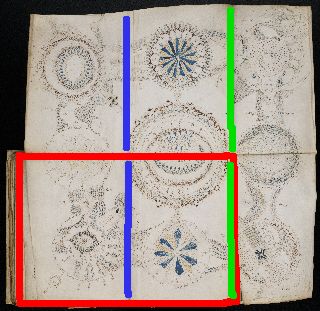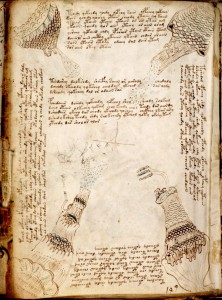I’ve waited a decade to find anything good on the Rohonc Codex (and don’t get me started on Wikipedia yet again), so it is with great delight that I read Benedek Lang’s April 2010 Cryptologia article “Why Don’t We Decipher an Outdated Cipher System? The Codex of Rohonc” that he kindly mentioned in a comment on this site a few days ago.
Despite the slightly clunky title, I think it is fair to say that Lang’s piece utterly replaces pretty much all the previous writing on the subject, and arguably moves the Rohonc Codex very nearly on a par with the Voynich Manuscript. Really, it is almost unnerving to find out that the RC suffers from precisely the same issues bedevilling VMs research:
- wide possible date range (1530s [from the Venetian paper] to 1838 [when it was donated by Count Gusztáv Batthyány])
- uncertain provenance (one possible mention in a 1743 inventory, but that’s it)
- inability to narrow down the plaintext language (Old Hungarian? Latin? or what?)
- apparently unhelpful drawings (probably representing a life of Christ, but offering very few cribs)
- non-trivial cipher nomenclator / shorthand combination (in my opinion)
- dominant hoax narrative (but which is at odds with the early dating of the support medium)
- unsubstantiated links to murky historical figures (forger Sámuel Literáti Nemes rather than Dee & Kelley)
- inadequate codicological and palaeographical analyses (by modern standards)
- multiple hands contributing to the object’s construction (two in the case of the RC, it would appear)
To me, the RC and the VMs (and their complicated mad ecologies of attempted decryptions) seem like two expressions of the same underlying historical pathology – when the aspirational desire to reconstruct the what overwhelms the grounding need to look for the how. Hence I asked Benedek Lang the same kind of “Voynich 2.0” questions I try (in vain) to start from these days, to round out the parts of his article that are less obviously cryptological (yet still important). Here are his responses (very lightly edited)…
* * * * * * *
[NP] (1) Has anyone done a codicological analysis of the Rohonc Codex? That is, how confident should we be that the bifolios remain in their original gatherings/quires and nesting order and that no bifolios have been lost, and when was the cover added, etc? Are there any signs of multiple rebindings? Are there any fingerprints?
[BL] No fingerprints, but basically anyone can touch it in the library, and some people in the 19th century even made notes in it. There had been a little research regarding the watermark, which I largely confirmed with my own research, though this however says nothing about the writing itself (which might of course be a later addition). The beginning and the end of the book are quite destroyed, to the point that the first and last 20 pages are no longer bound into the book, hence their (19th century) numbering might well be wrong. I think the book is in its original binding, which is not a real binding, just a piece of leather.
(2) Has there been a systematic study of any apparent corrections by the author(s)? For example, I notice a line apparently crossed out in Figure 5, or is that just boxed for emphasis?
No, nothing. My impression is that the corrections do not say anything that makes sense to me, but I should perhaps pay more attention to this.
(3) Has there been a palaeographic study of the text itself? For example, might it have (Leonardo-style) been written right-to-left for convenience by a left-hander? And have the palaeographic differences between the hands been described carefully? For example, did all the hands form the letters in the same way?
No, nothing, although it would be good to know whether there really are two hands – as it appears to me – and whether the text was written by one left handed person (or two), or just in the other direction by a right handed person.
(4) Has there been a palaeographic study of the marginalia and (what appear to be) interlinear notes? As with the VMs’ 15th century quire numbers and marginalia, dating the folio numbers might give a far more limiting (if pragmatic) terminus ante quem – really, there ought to be _some_ internal evidence that can help improve on 1838, which in historical terms is practically yesterday.
These marginalia were made by one of the less clever late 19th century “scholars” who believed that they were able to decipher the text.
(5) Apart from the introduction of new symbols, are there any signs of evolution or development of the core writing system through the 450 pages? As new symbols are added, are they progressively more ornate (which would argue for them being improvised, rather than as part of a pre-existing system)? Furthermore, are there any places where a new symbol is added in a left-right textual context which recurs around a word earlier in the document? (This would again argue for a nomenclator being improvised during the writing process).
There are certainly some occasional changes – for example, one of the symbols (the winged one) becomes less ornate – but apart from this I do not see any systematic changes. It is also true that new signs are introduced when there is a new person in the text (Pilate, for example). But I have not done serious research into that question.
(6) Did the Battyhany family ever compile inventories of their library? Has anyone looked for provenance in this kind of way?
Yes! There are several partial inventories of this very large library, and some earlier Rohonc Codex scholars thought that a book entitled “Hungarian prayers” in a 18th century inventory referred to this book. However, I remain skeptical, for I would be more satisfied by an inventory entry along the lines of “a book with unknown signs”. Such a description, however, is absent from the catalogues, the last one of which is dated exactly 100 years before 1838, when the codex first appeared.
As a general comment, I’d say that the lacuna in your account of shorthand is between Tironian notae and Bright’s Characterie. In Italy, Quattrocento scribes built up local traditions of abbreviations, with “underbars” and (macron-like) “overbars” for contraction and abbreviation (there are even some of these in Alberti’s facade for Santa Maria Novella). Isaac Pitman’s history of shorthand also mentions (p.6) a (probably 16th century) “Mr Radcliff, of Plymouth” whose version of the Lord’s Prayer – “Our Fth wch rt n hvn : hlwd b y Nm” – looks rather like modern SMS txtspk! What links many of these, then, is that they were ugly systems of abbreviation mainly intended to capture charismatic sermons as they were spoken: and so Bright’s innovation was to make the strokes easy to write, rather like Greek tachygraphy (which, though it was used in antiquity and in the Byzantine Empire, never seems to have crossed over into Europe).
Thanks! I was not aware of that.
In this context, then, the Rohonc Codex’s awkwardly angular letter forms seem to me quite independent of the many post-Bright shorthands: and also seem to have nothing structurally corresponding to the characteristic underbars or overbars of Quattrocento scribal practice. Hence to my eyes, it seems unlikely to fall within any known shorthand tradition, save that of pure abbreviation / contraction.
Yes, I agree.
As with the Voynich, I think the most likely scenario for the Rohonc Codex is that it is formed of a combination of (specifically abbreviating / contracting) shorthand and non-polyalphabetic cryptography (though it seems very likely that the VMs’ cryptographic aspect is many times more sophisticated than the Rohonc Codex’s): and it is this pairing when also combined with the lack of knowledge about the underlying language that makes it impractical to crack in a conventional way. In both cases, I suspect that the necessary first step will be to crack the history first!
Yes, but what can be done when almost nothing is known about its history? The Batthyány family might well have purchased it anywhere. In my mind, I imagine that it is a combination of a shorthand and a cipher, though lately however I am convinced that it is a consonant writing (due to a possible Turkish or Hebrew origin) and a cipher applied to that consonant language. (In fact, this is almost the same as saying that it is a cipher and a shorthand, because shorthands are usually composed of consonants.) I do not believe that it is a hoax because it is an ugly book, and I do not really know of any similar hoaxes from the pre-19th century period. I was, however, convinced that the Voynich Manuscript was itself a late 19th century hoax until I learned about its new dating. Hence I remain puzzled!
PS: do you have a picture of yourself I could include in the post? Thanks!

* * * * * * *
So there you have it – the Rohonc Codex is very probably, as Lang’s piece implies, just as uncertain as the VMs. Yet where are the massed ranks of me-too US documentary-makers clamouring to go to Budapest to view it? Why can’t we hear William Shatner’s voiceover ringing in our ears?
To me, the central mystery of the Rohonc Codex is therefore why its ‘ugly duckling’ cousin [the Voynich Manuscript] gets all the mad heresy theories when it’s the Rohonc Codex that has all the pictures of Christ. (Note to novelists & film companies: Budapest is much prettier than New Haven). Go figure!



